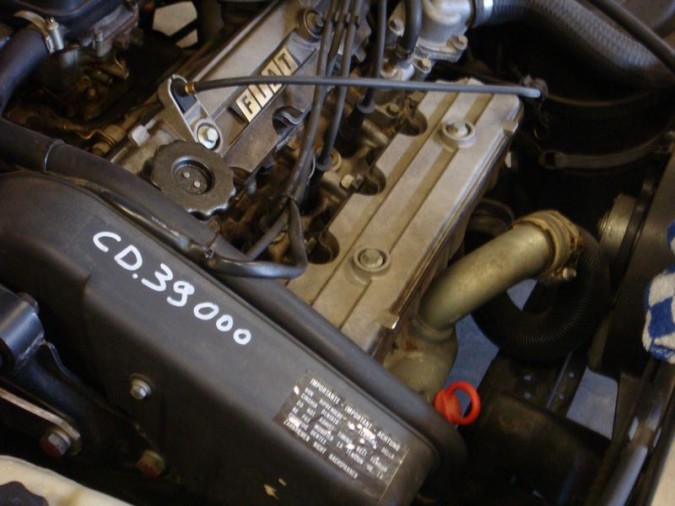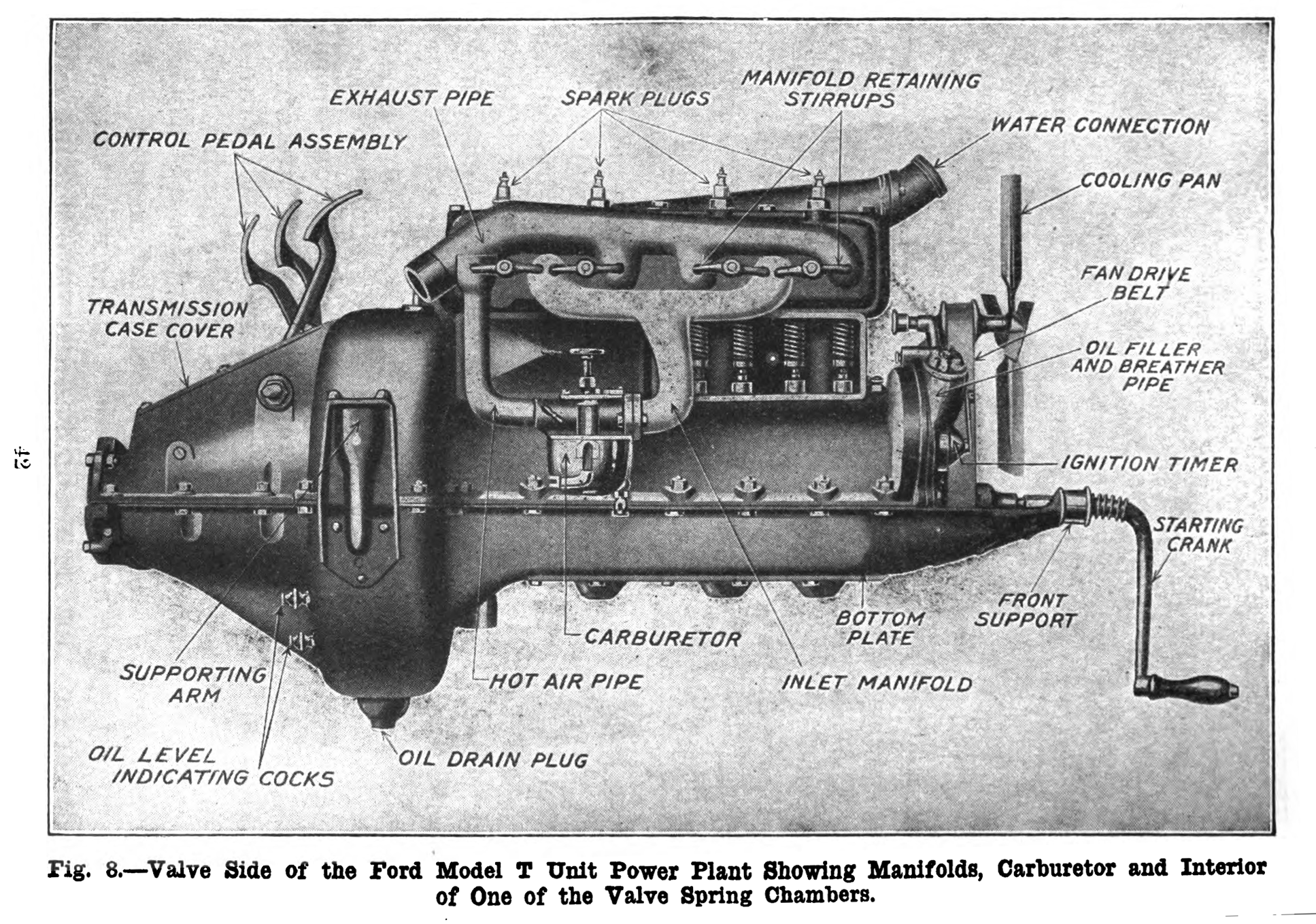|
Inline-four
A straight-four engine (also called an inline-four) is a four-cylinder piston engine where cylinders are arranged in a line along a common crankshaft. The vast majority of automotive four-cylinder engines use a straight-four layout (with the exceptions of the flat-four engines produced by Subaru and Porsche) and the layout is also very common in motorcycles and other machinery. Therefore the term "four-cylinder engine" is usually synonymous with straight-four engines. When a straight-four engine is installed at an inclined angle (instead of with the cylinders oriented vertically), it is sometimes called a slant-four. Between 2005 and 2008, the proportion of new vehicles sold in the United States with four-cylinder engines rose from 30% to 47%. By the 2020 model year, the share for light-duty vehicles had risen to 59%. Design A four-stroke straight-four engine always has a cylinder on its power stroke, unlike engines with fewer cylinders where there is no power stroke occu ... [...More Info...] [...Related Items...] OR: [Wikipedia] [Google] [Baidu] |
Triumph Slant-4 Engine
The Triumph slant-four is an inline four-cylinder petrol car engine developed by the Triumph Motor Company. It first appeared in 1968 in the Saab 99. The first Triumph model to use the engine did not appear until 1972. With an original capacity of 1.7 L, displacement grew over time to 2.0 L. Triumph production ended in 1981. History In 1963 Triumph's Chief Engine Designer Lewis Dawtrey presented the results of his analysis of future engine technology trends and Triumph's anticipated needs. After evaluating rotary, horizontally opposed, V4 and V6 configurations Dawtrey recommended an OHC engine family composed of both Inline-4 and V8 engines that could be built with the same tooling. The new range would be built in capacities of 1.5 L to 3.0 L, allowing it to replace both the four-cylinder Standard SC and derivative Triumph I6 engines whose roots reached back to the Standard Eight of 1953. The recommendation was accepted and development began in-house at ... [...More Info...] [...Related Items...] OR: [Wikipedia] [Google] [Baidu] |
Fiat Twin Cam Engine
Designed by ex Ferrari engineer Aurelio Lampredi, the Fiat Twin Cam (also known as the Lampredi Twin Cam) was an advanced inline-four automobile engine produced from 1966 through 2000 as a Fiat/Lancia engine until it was replaced by the "family B" Pratola Serra engine series. The engine was produced in a large number of displacements, ranging from and was used in Fiat, Lancia, Alfa Romeo, SEAT and Morgan cars. The Fiat Twin Cam engine has been widely used in motorsport and has been the most successful engine in the history of the World Rally Championship. Fiat and Lancia won a total of ten World Rally Championships for Manufacturers using engines based on the Lampredi Twin Cam engine. Design The engine uses the block of the OHV 124-series unit first found in the Fiat 124 with some modifications to accept the belt drive for the camshafts. The head itself is made in three pieces, one carrying the combustion chamber and valves and one separate casting for each camshaft in tunnel ... [...More Info...] [...Related Items...] OR: [Wikipedia] [Google] [Baidu] |
Volga (automobile)
The Volga (russian: Волга) is an executive car that originated in the Soviet Union to replace the GAZ Pobeda in 1956. Their role in serving the Soviet nomenklatura made them a contemporary cultural icon. Several generations of the car have been produced. Despite the continuous modernisations, GAZ found it increasingly difficult to keep the ageing design competitive in a market economy. GAZ CEO Bo Andersson decided to discontinue the Volga range in 2010. First Generation, the GAZ-M-21 Development The first Volga model was originally developed as a replacement for the GAZ-M20 Pobeda mid-size car which was produced from 1946. Despite its fastback design with Ponton body styling, the evolution of postwar automotive design and powertrain meant that in 1951 a brief was issued for its eventual replacement. In 1952 this matured into two projects: ''Zvezda'' ("Star"), an evolution of Pobeda's fastback contour with panoramic windows and large tailfins, and the ''Volga'' with ... [...More Info...] [...Related Items...] OR: [Wikipedia] [Google] [Baidu] |
Citroën DS
The Citroën DS () is a Front-mid-engine, front-wheel-drive layout, front mid-engined, front-wheel drive executive car manufactured and marketed by Citroën from 1955 to 1975, in fastback/sedan, wagon/estate, and convertible body configurations, across three series of one generation. Marketed with a less expensive variant, the Citroën ID, the DS was known for its aerodynamic, futuristic body design; unorthodox, quirky and innovative technology, and it set new standards in ride quality, car handling, handling, and braking — thanks to both being the first mass production car equipped with hydropneumatic suspension, as well as disc brakes. The 1967 series 3 also introduced ''directional headlights'' to a mass-produced car.After this feature was first introduced on the 1948 Tucker 'Torpedo', of which 50 were built. Italian sculptor and industrial designer Flaminio Bertoni and the French aeronautical engineer André Lefèbvre styled and engineered the car, and Paul Magès develop ... [...More Info...] [...Related Items...] OR: [Wikipedia] [Google] [Baidu] |
Flat-four Engine
A flat-four engine, also known as a horizontally opposed-four engine, is a four-cylinder piston engine with two banks of cylinders lying on opposite sides of a common crankshaft. The most common type of flat-four engine is the boxer-four engine, each pair of opposed pistons moves inwards and outwards at the same time. A boxer-four engine has perfect primary and secondary balance, however, the two cylinder heads means the design is more expensive to produce than an inline-four engine. Boxer-four engines have been used in cars since 1897, especially by Volkswagen and Subaru. They have also occasionally been used in motorcycles and frequently in aircraft. Cessna and Piper use flat four engines from Lycoming and Continental in the most common civil aircraft in the world - the Cessna 172, and Piper Cherokee, while many ultralight and LSA planes use versions of the Rotax 912. Design Most flat-four engines are designed so that each pair of opposing pistons moves inwards and o ... [...More Info...] [...Related Items...] OR: [Wikipedia] [Google] [Baidu] |
V4 Engine
A V4 engine is a four-cylinder piston engine where the cylinders share a common crankshaft and are arranged in a V configuration. The V4 engine is less common compared to straight-four engines. However, V4 engines have been used in automobiles, motorcycles, and other applications. Design Most V4 engines have two crankpins that are shared by opposing cylinders. The crankshaft is usually supported by three main bearings. Compared to the more common inline-four engine layout, a V4 engine is much shorter. Although different V angles can be used, if the two pistons are at a 90° V-angle with shared crankpins, the engine offers the additional advantage of perfect primary balance that reduces vibration. The design can also result in a smaller rocking couple than an inline-four engine, and the shorter crankshaft is less susceptible to the effects of torsional vibration due to its increased stiffness. Disadvantages of V4 engines include its design being inherently wider compared to in ... [...More Info...] [...Related Items...] OR: [Wikipedia] [Google] [Baidu] |
Ford Model A (1927)
The Model A is the designation of two cars made by Ford Motor Company, one in 1903 and one beginning in 1927: * Ford Model A (1903–1904) * Ford Model A (1927–1931) The Ford Model A (also colloquially called the A-Model Ford or the A, and A-bone among hot rodders and customizers) was the Ford Motor Company's second market success, replacing the venerable Model T which had been produced for 18 years. It wa ... {{disambiguation Model A Rear-wheel-drive vehicles ... [...More Info...] [...Related Items...] OR: [Wikipedia] [Google] [Baidu] |
Ford Model T Engine
The Ford Model T used a sidevalve, reverse-flow cylinder head inline 4-cylinder engine. It was primarily a gasoline engine. It produced for a top speed of . It was built in-unit with the Model T's novel transmission (a planetary design), sharing the same lubricating oil. The T engine was known for its simplicity, reliability, and economy. The engine remained in production for many years, and millions of units were produced. The engine design's lifespan exceeded that of the Model T vehicle itself, with industrial, marine, and military applications extending its production run. The T engine is on the Ward's 10 Best Engines of the 20th Century list. Fuel choices and fuel economy The Model T engine was built as a gasoline engine. While not engineered specifically for multifuel ability, its simple, robust design allowed a modified engine to successfully run on a variety of combustible fuels including benzene, ethanol, or kerosene. According to Ford Motor Company, the Model T h ... [...More Info...] [...Related Items...] OR: [Wikipedia] [Google] [Baidu] |
Variable Valve Timing
In internal combustion engines, variable valve timing (VVT) is the process of altering the timing of a valve lift event, and is often used to improve performance, fuel economy or emissions. It is increasingly being used in combination with variable valve lift systems. There are many ways in which this can be achieved, ranging from mechanical devices to electro-hydraulic and camless systems. Increasingly strict emissions regulations are causing many automotive manufacturers to use VVT systems. Two-stroke engines use a power valve system to get similar results to VVT. Background theory The valves within an internal combustion engine are used to control the flow of the intake and exhaust gases into and out of the combustion chamber. The timing, duration and lift of these valve events has a significant impact on engine performance. Without variable valve timing or variable valve lift, the valve timing is the same for all engine speeds and conditions, therefore compromises are neces ... [...More Info...] [...Related Items...] OR: [Wikipedia] [Google] [Baidu] |
Alfa Romeo Twin Cam Engine
The Alfa Romeo Twin Cam engine is an all-alloy inline-four engine series produced by Alfa Romeo from 1954 to 1994. In Italian it is known as the "bialbero" ("twin-shaft"), and has also been nicknamed the "Nord" (North) engine in reference to its being built in Arese, close to Milan, in the North of Italy and to distinguish it from the Alfa Romeo Boxer engine built in the South (Sud) for the Alfasud. History The Twin Cam's predecessor appeared in the 1950 Alfa Romeo 1900 and was an under-square inline four cylinder with a cast-iron block, an aluminium alloy crossflow cylinder head with double overhead cams and a 90° included angle between intake and exhaust valves. Development of that engine was overseen by Orazio Satta Puliga who would also helm development of its successor. The 1952 Disco Volante had a 2-litre DOHC four cylinder engine with an aluminium block and sleeves, but this seems to have been a custom version of the 1900 engine rather than a prototype of the forthcom ... [...More Info...] [...Related Items...] OR: [Wikipedia] [Google] [Baidu] |
Mitsubishi 4M4 Engine
The Mitsubishi 4M4 engine is a range of four-cylinder diesel piston engines from Mitsubishi Motors, first introduced in the second generation of their Montero/Pajero/Shogun SUVs. They superseded the previous '' 4D5'' engine family, main differences are enlarged displacements and the utilization of one or two over-head camshafts. Originally available only as a 2835 cc intercooled turbo, detail improvements in 1996 and a larger 3.2 litre option in 1999 served to improve power, torque, fuel economy and emissions. The final version has 3.0 litres swept volume and Common rail direct injection. 4M40 Inline 4-cylinder SOHC, bore x stroke = , , swirl combustion chamber Naturally aspirated Compression ratio 21.0:1, Zexel Distributor type injection pump, at 4000 rpm, at 2000 rpm Applications: * 1996-1999 Canter (lightest-duty), , @ 2000 rpm Intercooled Turbo Gen 1 Compression ratio 21.0:1, at 4000 rpm, at 2000 rpm Applications: * 19 ... [...More Info...] [...Related Items...] OR: [Wikipedia] [Google] [Baidu] |







